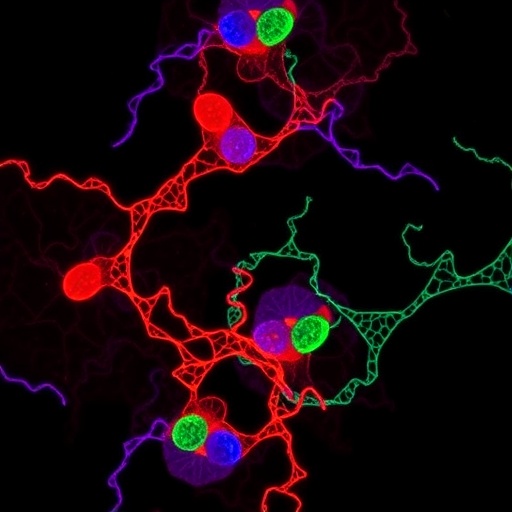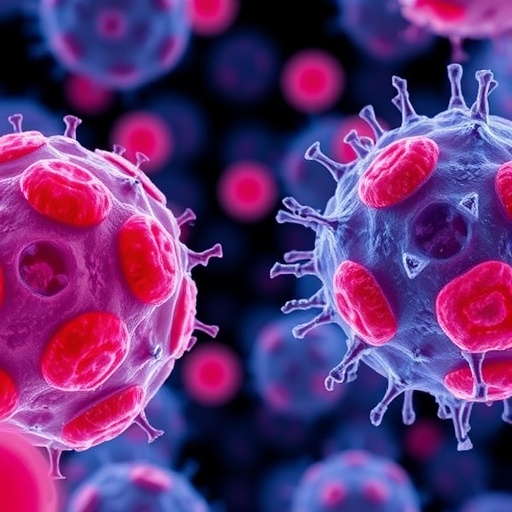In an exciting development within the field of ocular research, a novel study focuses on the biochemical intricacies of diabetic retinopathy, a leading cause of vision impairment worldwide. The research, conducted by Luo, Sun, Hu, et al., unveils a complex interplay between lactylation, the enzyme ALKBH5, and the regulatory mechanisms of RNF123 in retinal Müller cells. This groundbreaking study has significant implications for understanding the molecular underpinnings of retinal cell activation in the context of diabetes.
As diabetes progresses, it triggers a cascade of metabolic changes that lead to retinal damage. Diabetic retinopathy is characterized by oxidative stress, inflammation, and ultimately, cell death. The researchers delve into lactylation, a post-translational modification that adds a lactate group to lysine residues in proteins, which has emerged as an essential regulator of various cellular processes, including gene expression and enzyme activity. This modification highlights the intricate relationship between metabolism and epigenetic regulation, offering a fresh perspective on diabetic complications.
At the heart of the study is the role of the enzyme ALKBH5, known for its demethylation activity on RNA. ALKBH5 is pivotal in regulating the stability and modification of mRNA, influencing gene expression dynamics. The research presented by the authors demonstrates that lactylation can induce ALKBH5 activity, further linking metabolic alterations to epitranscriptomic changes in retinal Müller cells, which are critical for maintaining retinal homeostasis.
Furthermore, RNF123, an E3 ubiquitin ligase, emerges as a vital player in this biochemical narrative. The study elucidates how ALKBH5 targets RNF123, leading to a cascade of events that exacerbate retinal Müller cell activation. By ubiquitinating specific substrates, RNF123 regulates various signaling pathways associated with inflammation and cell survival, which are critical in the retinal environment. This intricate mechanism presents a novel target for potential therapeutic interventions.
The research findings indicate that the metabolic shifts associated with diabetes, particularly increased lactate levels, activate ALKBH5 in Müller cells, subsequently promoting the ubiquitination of RNF123. This interaction leads to augmented glycolytic activity through the enzyme PKM2, a key regulator of glucose metabolism. As a result, retinal Müller cells shift towards a more activated and inflammatory phenotype, contributing to the pathological progression of diabetic retinopathy.
With this understanding, researchers now consider the lactylation pathway as a potential therapeutic target. By modulating ALKBH5 activity or disrupting the lactylation of substrates involved in DNAB1 and RNF123 signaling pathways, it may be possible to alleviate the detrimental effects of Müller cell activation in diabetic retinopathy. However, it raises the question of whether intervention at this stage would be feasible without disrupting normal retinal functions.
Recent advancements in gene editing technologies and metabolic manipulation present new avenues for therapeutic development. Researchers are exploring the potential of CRISPR technology and small molecules that selectively inhibit ALKBH5 activity, or alternatively, enhance the functions of protective pathways that counteract the activation of RNF123. These strategies, if successful, could revolutionize the management of diabetic retinopathy and improve outcomes for millions of individuals affected by this condition.
Moreover, the implications of lactylation extend beyond just retinal biology. The study prompts further inquiries into the role of metabolic alterations and epigenetic changes in other tissues affected by diabetes. Unraveling these complex relationships may offer additional insights into the systemic effects of hyperglycemia and its associated complications across various organ systems.
As diabetic populations continue to rise globally, research such as this underscores the urgent need to comprehend and combat the molecular challenges posed by the disease. The collaborative efforts of multidisciplinary teams combining expertise in biochemistry, ophthalmology, and molecular biology are crucial for translating these findings into clinical practices. Greater awareness of the lactylation-induced pathways could pave the way for innovative therapies that offer hope for those at risk of vision loss due to diabetes.
The importance of this study lies not only in its immediate findings but also in the broader implications it holds for future research endeavors. Investigating the metabolic and epitranscriptomic landscape of Müller cells could open doors to new paradigms in understanding diabetes-related complications. As researchers delve deeper into these pathways, the potential for discovering novel biomarkers for early detection and progression monitoring of diabetic retinopathy becomes tangible.
Ultimately, the intersection of metabolism and epigenetics predicts an evolving narrative in the etiology of diabetic complications. The compelling data presented by Luo et al. emphasizes a need for a shift in therapeutic strategies, one that considers the metabolic status of cells as intrinsic to their functional outcomes. Understanding the lactylation-ALKBH5-RNF123 axis may very well represent a cornerstone for future exploration and innovative treatment strategies aimed at addressing the multifaceted nature of diabetes and its consequences.
Given the promising findings presented, it is clear that we are only beginning to scratch the surface of how lactylation affects cellular behavior. Future studies are expected to further elucidate these mechanisms, potentially revealing novel interventions that could alter the course of diabetic retinopathy and bring renewed hope to those affected. In the ever-evolving landscape of biomedical research, studies like this illuminate the path towards understanding complex diseases and adapting our therapeutic approaches accordingly.
In conclusion, this study serves as a crucial reminder of the interconnectedness of metabolic processes and gene regulation, shedding light on how seemingly disparate elements converge to influence disease outcomes. The future of diabetic retinopathy treatment may very well hinge on our ability to navigate and manipulate these intricate pathways, making this an exciting time for researchers and clinicians alike who are dedicated to improving the lives of patients suffering from diabetes-related complications.
Subject of Research: Diabetic retinopathy and the role of lactylation-induced ALKBH5 in retinal Müller cell activation.
Article Title: Lactylation-induced ALKBH5 targets RNF123 to worsen retinal Müller cell activation through PKM2-regulated Glycolysis in diabetic retinopathy.
Article References:
Luo, S., Sun, Y., Hu, Y. et al. Lactylation-induced ALKBH5 targets RNF123 to worsen retinal Müller cell activation through PKM2-regulated Glycolysis in diabetic retinopathy. J Transl Med 23, 1105 (2025). https://doi.org/10.1186/s12967-025-07129-3
Image Credits: AI Generated
DOI: 10.1186/s12967-025-07129-3
Keywords: Diabetic Retinopathy, Lactylation, ALKBH5, RNF123, Müller Cells, Glycolysis, Metabolism, Epitranscriptomics, Therapeutic Targets.
Tags: biochemical pathways in diabetic eye diseaseepigenetic regulation in diabetesgene expression dynamics in retinal cellsinflammation and vision impairmentlactylation and diabetic retinopathymetabolic changes in diabetic retinopathymolecular mechanisms of diabetic complicationsoxidative stress and retinal damagepost-translational modifications in diabetesretinal Müller cells and lactylationRNF123 regulation in retinal cellsrole of ALKBH5 in ocular health





